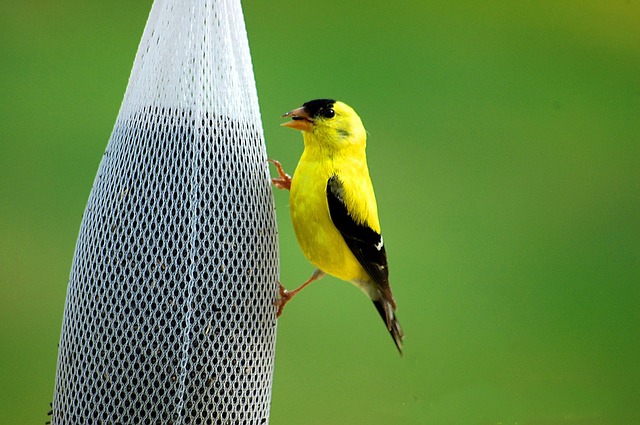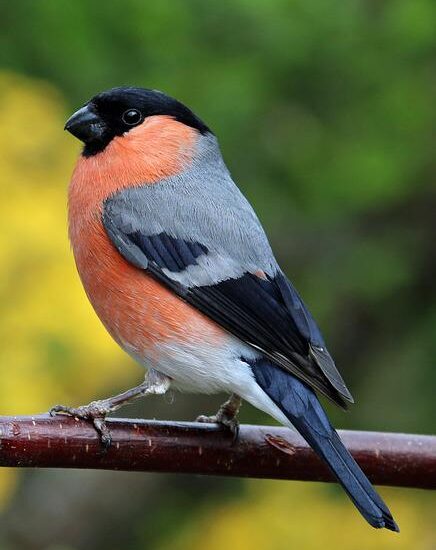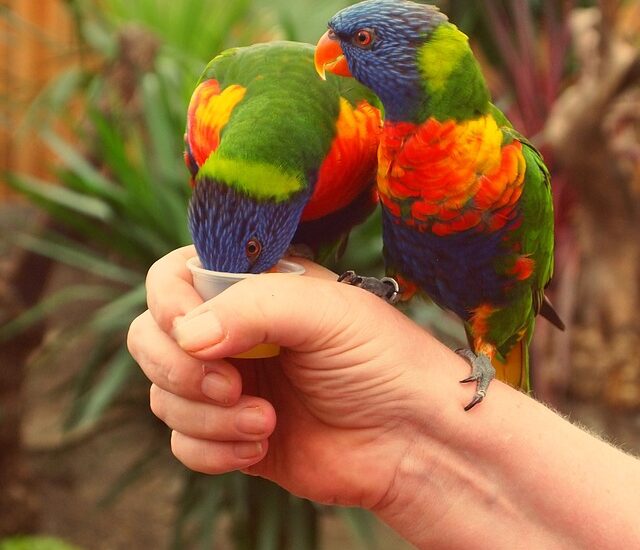What Do Yellow Finches Eat? Food That Attracts Them in A Yard
Yellow finches, also known as American goldfinches, can be easily found across North America. The males have bright yellow plumage, while the females have a slightly dull coat of yellow, often with other colors like black, white, and brown on their tails, wings, and around the eyes.
These finches are an impressive sight to behold, flitting from one branch to another in a blur of dazzling yellow feathers. It is no wonder that most bird enthusiasts are keen on attracting these beautiful birds to their yards, as besides providing the much-appreciated scenic beauty to one’s backyard they are also quite entertaining to observe.

- What Do Yellow Finches Eat?
- How To Attract Finches to Your Yard?
- 1- Best Type of Seeds to Attract Finches
- 2- Best Types of Bird Feeders to Attract Finches
- 3- Correct Positioning of The Bird Feeder in Your Yard
- 4- Adding A Water Bath to Your Yard to Attract Finches
- 5- The Perfect Environment to Attract Finches to Your Yard
- 6- Planting trees and shrubs to attract yellow finches for nesting in your yard
- Some Other Tricks to Attract Yellow Finches to Your Yard
- Frequently Asked Questions
What Do Yellow Finches Eat?
Finches are granivorous animals, which means that their diet consists primarily of seeds, nectar, and fruits from plants. Although finches are capable of eating all these, they mainly rely on seeds for nutrients. They enjoy a wide variety of seeds including those of dandelion, millet, teasel, kernel, and flax, but they are particularly fond of thistle and sunflower seeds.
So, if you ever plan on tempting these beautiful finches to your yard, these should be your go-to snacks to offer them.
Every once in a while, finches will also snack on weeds, grass, berries, fresh flower buds, leaves, pinecones, and sap from the trees; however, the seeds remain a primary source of nourishment for these vibrant creatures.
Finches, unlike other small birds, do not eat insects. Even as babies they are not fed worms but rather seeds from the beginning. In a sense, they are quite strict herbivores of the animal kingdom.

How To Attract Finches to Your Yard?
If you have recently discovered your passion for birdwatching or are a pro bird enthusiast and have been wondering how you may get these beautiful creatures to visit your backyard, you shouldn’t worry and just focus on following the few tips and tricks mentioned in this article.
Attracting finches is an easy task depending on whether you can provide them with a place they presume to be safe and worth stopping over. These tips will help you create a safe space for the finches, where they can sojourn throughout the year, regardless of the season.
1- Best Type of Seeds to Attract Finches
Yellow finches are particularly fond of thistle (Nyjer) seeds and sunflower seeds, but they will also eat kernels, millet, teasel, and flax seeds. Therefore, when filling your bird feeders make sure to include hulled thistle and sunflower seeds both of which have high oil content. Sunflower seeds are preferred by many of the other birds too, hence including sunflower seeds in your bird feeder might attract a wider variety of birds to your yard, amplifying your yard’s beauty.
Despite their innocent appearance that tricks a person into thinking that these tiny, feathered creatures will eat any type of seed available to them, they are quite a picky eater. They prefer to eat fresh, oil-rich seeds through which they can get the maximum amount of nutrients.
So, when stocking your feeder with seeds, make sure that they are fresh and black in color, as seeds that have turned slightly brown have lost most of their oil content and these clever finches can tell the difference and won’t eat those seeds, leaving you wondering what you are doing wrong.
To deal with seeds drying out, change the seeds in the feeder often, don’t buy large quantities of seeds, just enough for a month at most, and store them in a refrigerator before feeding them.
2- Best Types of Bird Feeders to Attract Finches
Goldfinches are one of the few birds that are easily attracted to bird feeders placed in the yard. Although, the type of bird feeder that you use can make a significant impact on whether the birds choose to visit your yard or not.
Primarily, there are two types of feeders used, the sock feeder, and the feeder tube.
Sock Feeder
These are made of mesh-like fabric, which the finches can grab on to easily and use their small, conical-shaped beak to grab the seeds from within the feeder. The holes in the feeder are so tiny that they can easily hold all the types of seeds that finches love, while also being easily accessible to the small finches.
Sock feeders are preferred for feeding finches as large birds that are a threat to the tiny finches don’t come to feed on these sock feeders, thus providing a predator-free area where the finches can eat comfortably. These feeders also allow ventilation through the seeds, so they don’t collect moisture causing the seeds to collect mold which the squirrels don’t like.

Mesh Feeder
These are one the most durable types of feeders, made of metal with mesh type design. They also generally have a circular plate-like platform attached to the bottom of the feeder where the finches can perch and eat comfortably.
These are preferred, because, unlike the sock feeders whose fabric wears out easily due to being constantly grabbed by the finches, and needs replacing every few months, these feeders have a comparatively longer life, while also deterring animals like squirrels that attempt to steal the seeds from the feeder. Their mesh-like design, like the sock feeder, is favored because it allows ventilation through the seeds keeping them fresh for longer.
3- Correct Positioning of The Bird Feeder in Your Yard
If you are placing a bird feeder in your yard for the first time, you should aim to place it near the trees or shrubs, so that when the finches see them from above, they feel safe enough to explore the feeder from close, without the constant threat of being attacked, if the feeder was placed out in the open.
Although after some time, when the finches start to visit the feeder regularly, you should gradually move the feeder away from the tree, to prevent animals, like squirrels, from jumping on the feeder and scaring the finches.
Always hang the feeders from a high platform, though not necessarily from tree branches, and when introducing a new feeder in your yard fill it up only half with seeds, as that seems to attract the finches more.
When adding a new feeder to your yard, where you already have a few feeders placed previously, temporarily remove the other feeders, as finches that are used to going to the other ones won’t explore the new one. When the finches start visiting the new feeder, feel free to bring back the previous feeders too.
4- Adding A Water Bath to Your Yard to Attract Finches
Finches like many other birds love a good water source, whether it’s to drink water to quench their thirst or to cool themselves in the blazing heat of the afternoon. Adding a water bath to your yard won’t just increase the aesthetics of your backyard but will also attract finches.
Yellow finches generally migrate in winter, to find someplace where the water source isn’t frozen, and food is available. So, it is a good idea to add a water bath to your yard, especially in winter, as finches might not migrate if they know they have a stable source of water and food available, and even if they do migrate, they know that they have a place to return to with a steady supply of nourishment.
5- The Perfect Environment to Attract Finches to Your Yard
To make your yard the best spot, in which the finches want to explore and rest, you can’t just go for the plain perfectly manicured grass lawn with a few trees at the edges, as this holds no attraction for the finches. Finches being wild birds prefer a yard with a wilder edge to it.
If you want to attract finches to your yard you should plant grass that has weeds, shrubs, and flowers that produce oily seeds including those of sunflowers, thistle, asters, cup plants, and coneflowers, and tall trees like pine trees, to provide shade and a good hiding place.
Planting thistle in your yard, won’t just aid in attracting finches who want to feed on it but will also attract finches who are planning on nesting as yellow finches mostly use thistledown to make their nest.
Adding a water bath will also increase the overall value of your yard for the birds which like sources of running water.
6- Planting trees and shrubs to attract yellow finches for nesting in your yard
Yellow finches generally nest in tall trees, although sometimes you will find them nesting in dense shrubs. Basically, whatever their area provides them with, which best provides shelter to their nests from predators and natural phenomena like rain, and snow, that’s what the finches will use to make their nest.
Their nest is cup-shaped; therefore, they require more support to form the hollow cup, using thistle, dandelion, and milkweed to line their nest while they often nest in trees like willow, dogwoods, hawthorns, elm, cedar, alder, and fruit trees.
Planting these shrubs and trees in your garden will increase your yard’s attraction for the finches, making them visit your yard for reasons other than feeding, throughout the year.
Some Other Tricks to Attract Yellow Finches to Your Yard
1- Replace the seeds left in the feeder every few weeks, as finches don’t eat dried seeds.
2- Add a rain guard to your finch feeder to prevent the seeds from getting wet, as finches don’t eat moist, moldy seeds and they have trouble pulling the seeds out of the feeder with their beaks if they clump together due to the moisture.
3- Finches are extremely sensitive to colors, so, when adding a new feeder to your yard, tie a few yellow ribbons to it, the fluttering ribbons will catch their attention and cause them to stop over and investigate the new bird feeder. It will also lull them into a sense of safety that other finches have already visited the new site. You can remove the ribbon later after a few weeks if you wish to do so.
4- Add branches of plants like thistle, sunflower, and brightly colored flowers to the holes in your bird feeder, so the finches can see from far that it’s a feeding source and will descend to explore it.
5- Add branches or perch sticks near your bird feeder so that the finches can grab them comfortably while feeding or waiting for their fellows to eat.
Frequently Asked Questions
How to clean my bird feeder? And how often?
Yellow finches’ bird feeder needs to be always clean, as they don’t feed on dirty or moldy bird feeders. To clean your birdfeeder, empty out all the seeds in it, into a clean bowl, take apart the feeder as much as you can and then individually wash all the pieces to get rid of the build-up dust and debris present on it, you also need to remove any mold if it’s there. You can use a dishwasher detergent for cleaning, but make sure that all of it is washed off using mild or hot water.
Let the feeder dry completely before reassembling it and putting the old seeds back in if they are still fresh or add new seeds if the old ones have dried out.
How can I keep other animals from my finch feeder?
Animals like squirrels, jumping on your bird feeders are a nuisance to you and your beloved yellow finches who visit these feeders to eat in peace. To keep your feeder free from these pests, make sure to place your feeder at least ten feet away from trees or plants, and about ten feet above ground too



